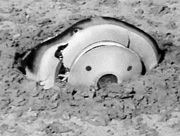 |
| This NASA
television image shows the Genesis return capsule on the
ground as it landed in Dugway Proving Ground, Utah.(AFP/NASA
TV-HO) | |
A space capsule returning solar particles to Earth crashed in the
Utah desert on September 8th after its parachute failed to open, but
scientists were hoping that the star dust inside might have been
saved.
A Hollywood stunt pilot was supposed to snag the Genesis
capsule as it floated toward Earth on a parachute at the end of its
three-year mission to collect solar ions.
But the capsule's parachutes failed to open, and the spacecraft tumbled
out of control and struck the ground at 193 miles per hour six minutes
after entering Earth's atmosphere.
The flight had gone smoothly until moments before impact, which left
the 450-pound capsule half buried in the sand about 31 miles from the U.S.
Army's Dugway Proving Ground, where the Genesis team watched a live aerial
broadcast of the events.
"Certainly now we are in a situation where the scientists ... are going
to have to deal with a lot more contamination than they were hoping
for," Genesis project manager Don Sweetnam said at a briefing at Dugway
shortly after the crash.
Charles Elachi, director of the Jet Propulsion Laboratory in Pasadena,
California, where the mission was based, said he was "still hopeful."
"All the data is there," Elachi said. "The question is: 'How
contaminated is it?' It will make it much harder to analyze."
The spacecraft collected ions that had been blown by solar winds on
wafers of silicon, diamond, sapphire, gold and other materials.
It was the first extraterrestrial matter to be returned to Earth by a
spacecraft since the U.S. Apollo and Soviet Luna missions brought back
moon rocks in the 1970s.
Scientists hoped that study of the materials would yield insights about
the early formation of planets and the dawn of the solar system.
An initial check of the spacecraft showed that several pyrotechnic devices failed to fire
and deploy the chutes, but the reason for the multiple failures was
unclear, Andrew Dantzler, NASA solar system division director, said.
(Agencies) |
9月8日,由于降落伞出现故障无法打开,美国“起源”号太阳探测飞船的返回舱一头栽进犹他州的沙漠中。“起源”号返回舱的任务是将采集到的太阳离子送回地球。但是科学家们仍然希望舱内的外星物质能够被保存下来。
三年来,“起源”号太阳探测飞船的主要任务就是收集太阳粒子。在完成该使命后,飞船借助降落伞返回地球。按计划,一位好莱坞的特技飞行员将对返回舱实施空中拦截。
但是由于返回舱的降落伞未能打开,返回舱失去控制,在空中翻转。在进入地球大气层6分钟后,以每小时193英里的速度一头栽到沙漠中。
撞击发生前,飞船的飞行状况一直很平稳。这次撞击使450磅重的返回舱一半陷入了距美军杜格威试验基地31英里远的沙漠中。“起源”号研究小组在试验基地观看了现场直播。
撞击发生后,随即在杜格威试验基地召开了简要的情况介绍会。会上,“起源”号项目负责人唐·斯威特纳姆说:“的确,现在我们的处境是:科学家们将不得不处理比想象中要多得多的污染。”
位于加利福尼亚帕萨迪纳的喷气推进实验室负责人查尔斯·叶拉奇说他仍然“抱有希望”。该实验室也是此次任务的基地之一。
叶拉奇说:“所有的数据都在返回舱里。问题是:‘受到污染的程度有多严重?' 污染会使对数据的分析工作变得更加困难。”
“起源”号太阳探测飞船用各种材料的晶片来收集被太阳风吹来的太阳粒子,其中包括硅、钻石、蓝宝石、金子和其它物质制成的晶片。
自上世纪70年代美国“阿波罗”号和前苏联“月球”号航天飞船带回月球岩石采集样本以来,这些太阳粒子是首批由太空飞船带回地球的外星物质。
科学家们希望对这些物质的研究能帮助人们解开行星和太阳系的起源之谜。
美国国家宇航局太阳系分部负责人安德鲁·丹泽尔说,对返回舱的初步检查显示几个点火装置点火失败,导致降落伞未能打开,但是导致重大失败的原因尚不清楚。
(中国日报网站译) |
